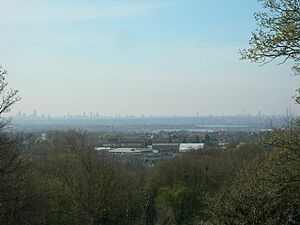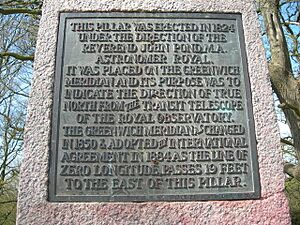Pole Hill facts for kids
Pole Hill is a special hill located in Chingford, which is in north-east London. It sits right on the edge between Greater London and the county of Essex. From the top of Pole Hill, you can see a wide view of London, looking towards the east, north, and west. However, during summer, the many trees in Epping Forest can sometimes block parts of the view.
Contents
Why is it Called Pole Hill?
The name "Pole Hill" has changed over a long time. The earliest record of its name was in 1498, when it was called "Pouls Fee" or "Pauls Fee." Later, in 1777, a map showed it as "Hawke Hill."
Understanding the Old Names
The name "Hawke" came from a nearby place called Hawkwood. In Old English, "Hawk" meant a small corner or nook. So, "Hawkwood" meant a wood located in a corner of the Chingford area.
The name "Paul" came from the fact that the hill was part of a large estate called Chingford Pauli. This estate was also known as Chingford St Paul's. It belonged to St Paul's Cathedral in London. The word "Fee" comes from a Middle English word meaning a large piece of land or estate. This shows that Pole Hill was once part of this big estate. After a tall stone monument, called an obelisk, was put on the hill, some people started calling it "Polar Hill," but this name did not last long.
Pole Hill and the Greenwich Meridian
Pole Hill is an important spot for understanding maps and the Earth. It is located in Epping Forest and sits exactly on the Greenwich Meridian. This imaginary line is marked as 0 degrees longitude on maps. The hill is also at 51 degrees and 38 minutes north latitude.
How High is Pole Hill?
At its highest point, Pole Hill is about 91 meters (or 299 feet) above sea level. Because it is the highest point directly visible from the Royal Observatory in Greenwich, it was once used as a marker. Geographers at the observatory used Pole Hill to help them set their telescopes and other equipment to a true zero-degree direction.
The Obelisk on the Hill
On the very top of Pole Hill, there is a tall, thin monument called an obelisk. It is made of granite stone and has an important message carved into it. The message explains that this pillar was put there in 1824. It was placed by a person named Reverend John Pond, who was the Astronomer Royal at the time.
The obelisk was meant to show the direction of true north from the observatory's special telescope. However, the exact line of the Greenwich Meridian was changed in 1850. In 1884, countries around the world agreed on this new line as the official zero longitude. This new line passes about 5.8 meters (19 feet) to the east of the obelisk. At that exact spot, there is another marker called an Ordnance Survey trig point, which shows the very top of the hill.
Famous People Connected to Pole Hill
Pole Hill also has a connection to a famous person named T. E. Lawrence. He was a British army officer known for his role in the Arab Revolt during World War I.
Lawrence's Dream Project
T. E. Lawrence once owned a lot of land on the western side of Pole Hill. He first rented the land and then started buying small pieces of it after the war. He had a dream of starting a special printing press with his friend, Vyvyan Richards, from Oxford. They wanted to print beautiful, high-quality books.
Lawrence was inspired by old medieval ideas and the craftsmanship of people like William Morris. They planned to build a medieval-style timber hall for their printing press. An architect named Herbert Baker was going to design it. Lawrence even built a small hut for himself there and lived in it for several years. His hut was later taken down in 1930 and rebuilt in a different place called The Warren, in Loughton.



